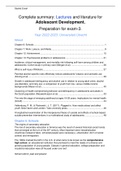Saskia Ensel
Complete summary: Lectures and literature for
Adolescent Development.
Preparation for exam-3.
Year 2022-2023. Universiteit Utrecht
Inhoud
Chapter 6: Schools ............................................................................................................... 1
Chapter 7: Work, Leisure, and Media .................................................................................... 8
Chapter 12: Achievement .................................................................................................... 15
Chapter 13: Psychosocial problems in adolescence ........................................................... 21
Incidence, clinical management, and mortality risk following self-harm among children and
adolescents: Cohort study in primary care (Morgan et al). .................................................. 36
What is self-injury (Whitlock) ............................................................................................... 37
Parental alcohol-specific rules effectively reduce adolescents’ tobacco and cannabis use
(Koning et al) ...................................................................................................................... 39
Growth in adolescent delinquency and alcohol use in relation to young adult crime, alcohol
use disorders, and risky sex: a comparison of youth from low- versus middle-income
backgrounds (Mason et al) .................................................................................................. 40
Clustering of health-compromising behavior and delinquency in adolescents and adults in
the Dutch population (Nieuwenhuijzen et al). ...................................................................... 43
The new life stage of emerging adulthood at ages 19-29 years: Implications for mental health
(Arnett). ............................................................................................................................... 44
Valkenburg, P. M., & Piotrowski , J. T. (2017). Plugged in. How media attract and affect
youth. New Haven and London: Yale university press......................................................... 46
A longitudinal examination of the interpersonal theory of suicide and effects of school-based
suicide prevention interventions in a multinational study of adolescents ............................. 48
Chapter 6: Schools
The origins of secondary education
The rise of secondary education in America was the result of several historical social trends
that converged at the turn of the 20th century. Most important were industrialization
(machines instead of labor, schooled people were necessary), urbanization (form of social
control) and immigration.
The 1920s marked the birth in the U.S. of what came to be known as the comprehensive
high school, an educational institution that promised to meet the needs of a diverse and
growing population of young people. Classes in general education, college preparation and
vocational education were all housed under one roof.
School reform: past and present
,Saskia Ensel
Schools offer education, provide breakfast and lunch to students from impoverished families,
offer extracurricular activities that keep students occupied and supervised during afternoon
hours, they are important for social intervention and provide socializing with peers.
No Child Left Behind (NCLB) → (Bush) required that schools create and enforce academic
standards by annually testing all students and by reporting the results of students’
performance to the public. But today, a huge proportion of American students do not meet
even minimal standards for academic performance and poor performance is
disproportionately seen among disadvantaged Black, Latinx and Native American students.
Many commentators had critized the practice of promotion – moving students from one
grade to the next regardless of their academic performance.
What should schools teach?
The past five decades have been dominated by what is called standards-based reform,
which focuses on policies designed to improve achievement by holding schools and students
to a predetermined set of benchmarks measured by achievement tests. This gave rise to
proposals that American schools adopt the Common Core, a set of standards in English
language arts and mathematics that school across the country would be expected to use to
evaluate whether their students were learning what they ought to learn in each grade. But
many states that signed on the plan have since then broken from it. Educators haven’t been
able to agree on the body of knowledge and skills that comprise what high school graduates
should know and be able to do. Increasing numbers of parents began to look at other
options, for example charter schools (public schools that are given more freedom to set
their own curricula), schools that are run by private corporations rather than local school
boards, home schooling and government-subsidized school vouchers.
Education in the inner cities
The education crisis is especially urgent within inner-city public schools. The achievement
gap between White and nonwhite youngsters, which had been closing for some time, grew
wider during the 1990s. It narrowed again toward the end of the 20th century but has
remained substantial since. Just 10% of the of the high schools in the United States produce
half of the country’s dropouts, and one-third of Black and Latinx students attend one of these
“dropout factories.” Why has school reform failed in so many urban schools? Experts point to
several factors: the concentration of poverty in many inner-city communities has produced a
population of students with an array of personal problems. Many urban school districts are
burdened by huge administrative bureaucracies that impede reform and hinder educational
innovation. Students in urban schools report less of a sense of belonging to their schools,
which leads to disengagement and poor achievement.
THE SOCIAL ORGANIZATION OF SCHOOLS
In addition to debating curricular issues, social scientist interested in school reform have
discussed the ways in which secondary schools should be organized:
School size and class size
One advantage enjoyed by larger schools is that they can offer a more varied curriculum.
But most research says that bigger isn’t better. They have found that student performance
and interest in school improve when their schools are made less bureaucratic and more
intimate. Numerous studies indicate that students achieve more when they attend schools
that create a cohesive sense of community. Students’ attachment to school is weaker in
larger schools, particularly with +4000 students. Studies also find that there is more
inequality in bigger schools. School size especially affects the participation of students
whose grades are not very good. In large schools, academically marginal students often feel
,Saskia Ensel
like outsiders and rarely get involved in school activities. School size does not affects
students mental health.
In contrast to studies of schools, studies of classrooms indicate that variations within the
typical range of classroom sizes – from 20-40 students – do not affect students’ scholastic
achievement once they have reached adolescents. An exception to this finding involves
situations that call for highly individualized instruction or tutoring, where smaller classes are
more effective.
Age grouping and school transitions
Many studies find that students’ academic motivation, school engagement and school
grades drop as they move from elementary into middle or junior high school. There is some
recovery of motivation and perseverance over the course of middle school, but after
increasing, these tend to plateau after the transition to high school. In general, school
transitions, temporarily disrupt the academic performance, behavior and self-image of
adolescents. More frequent school changes are associated with lower achievement as well
as higher rates of emotional and behavioral problems.
The classroom environment in the typical middle school or junior high school is
usually very different from that in the typical elementary school. Not only are junior high
schools larger and less personal, but middle and junior high school teachers hold different
beliefs about students than do elementary school teachers and are less likely than other
teachers to feel confident about their teaching ability.
Although students’ self-esteem drops during the transition into middle or junior high
school, it increases during the early high school years, so changing school itself isn’t the
problem. Although some aspects of the transition into secondary school may be difficult for
students to negotiate, not all students experience the same degree of stress. Students who
have more academic and psychosocial problems before making a school transition cope
less successfully with it. Factors other than students’ prior record also influence their
transition to middle or high school. Adolescents who have close friends before and during
the transition adapt more successfully to the new school environment, although the benefits
of staying with their friends accrue only to students who had been doing well previously.
Generally speaking, boys, ethnic minority students and students from poor families are more
likely to become disengaged from school during early adolescence. Parental support and
involvement also are associated with better adolescent adjustment during school transitions.
Schools transition involves many changes:
• Procedural changes
o Knowing how to change classes
o Longer distance to school, using a locker, lunch at school
• Academic changes
o More subjects
o Stricter grading
o Tracking
o More homework
• Social changes
o New classmates and teachers
o Being the youngest again
Cumulative change theory (Simmons)
Theory: transitions will be harder for children who experience several life changes at the
same time (e.g. pubertal development, change in residence, family disruption, dating).
, Saskia Ensel
Person-environment fit theory
Theory: negative changes in motivation and engagement after the school transition result
from a mismatch between the environment and the adolescents’ needs:
Students’ needs Secondary school compared to primary school
Need for autonomy and • Teachers less likely to trust students
control • Teachers more compelling
• Fewer opportuinities for student choices
Need for relatedness • Less personal relationships with teachers
Need for competence • Stricter grading practices
• Teachers more likely to think that abilities are fixed
• Focus on performance not mastery
Adverse consequences for school transitions likely for:
• Vulnerable students
• Students with few sources of social supports
• Students moving to impersonal schools
Tracking
Some classes are designated as more challenging and more rigorous and are reserved for
students identified as especially capable. The process of separating students into different
levels of classes within the same school is called ability grouping or tracking:
• Useful in high school where students must master certain basic skills
• Students in the remedial track receive worse education
• Students only socialize with peers from the same academic group → polarization.
• Decisions about track placements often discriminate against poor and ethnic minority
(contradictory evidence)
Early track placements set in motion an educational trajectory that is often difficult to change.
Being placed in a more advanced track has a positive influence on school achievement on
subsequent course selection and on ultimate educational attainment. Generally, tracking has
positive effects on the achievement of high-track students, negative effects on low-track
students, and negligible effects on students in the middle.
Even in schools that do not have formal tracking, teachers may group students within
the same class into ability groups. For high-ability students, within-classroom ability grouping
raises their expectations for achievement and raises their teachers evaluations of them; for
low-ability students they have lowered expectations and get worse grades.
Related to the issue of tracking are questions concerning the placement of individuals who
are considered gifted students and of those who have a learning disability. Adolescents
who score 130 or higher on an intelligence test are considered gifted. Adolescents with a
learning disability are those whose actual performance is significantly poorer than their
expected performance and whose difficulty with academic tasks cannot be traced to an
emotional problem. Common types are: dyslexia, dysgraphia (= impaired ability in
handwriting) and dyscalculia.
Educators have debated whether gifted students and those with learning disabilities
are best served by instruction in separate classes or by mainstreaming. One downside to
being placed with students of high academic ability is that when students compare
themselves to their high-achieving classmates, they don’t feel as competent as they would if
their point of comparison were students who were not so smart. This is called big fish-little
pond effect. Low-achieving students end up comparing themselves to students whose
performance is better and may end up feeling worse about themselves. Compared with






